Methodological Advances in the Design of Photovoltaic Irrigation
Abstract
:1. Introduction
2. Materials and Methods
2.1. General Description of the Photovoltaic Irrigation System
2.2. Crop Water Requirements
2.3. Supply and Demand Management: Daily Work Matrix
3. Case Study
4. Results
5. Conclusions
Author Contributions
Funding
Institutional Review Board Statement
Informed Consent Statement
Data Availability Statement
Conflicts of Interest
Appendix A. Mathematical Models of Components of the System
Appendix A.1. Photovoltaic Generator Subsystem
Appendix A.1.1. The Solar Resource
Appendix A.1.2. The Photovoltaic Generator
Appendix A.2. Frequency Variator Subsystem
Appendix A.3. Variable Speed Induction Motor Subsystem
Appendix A.4. Pumping Subsystem
Appendix A.4.1. Irrigation Network
Appendix A.4.2. Pumping System
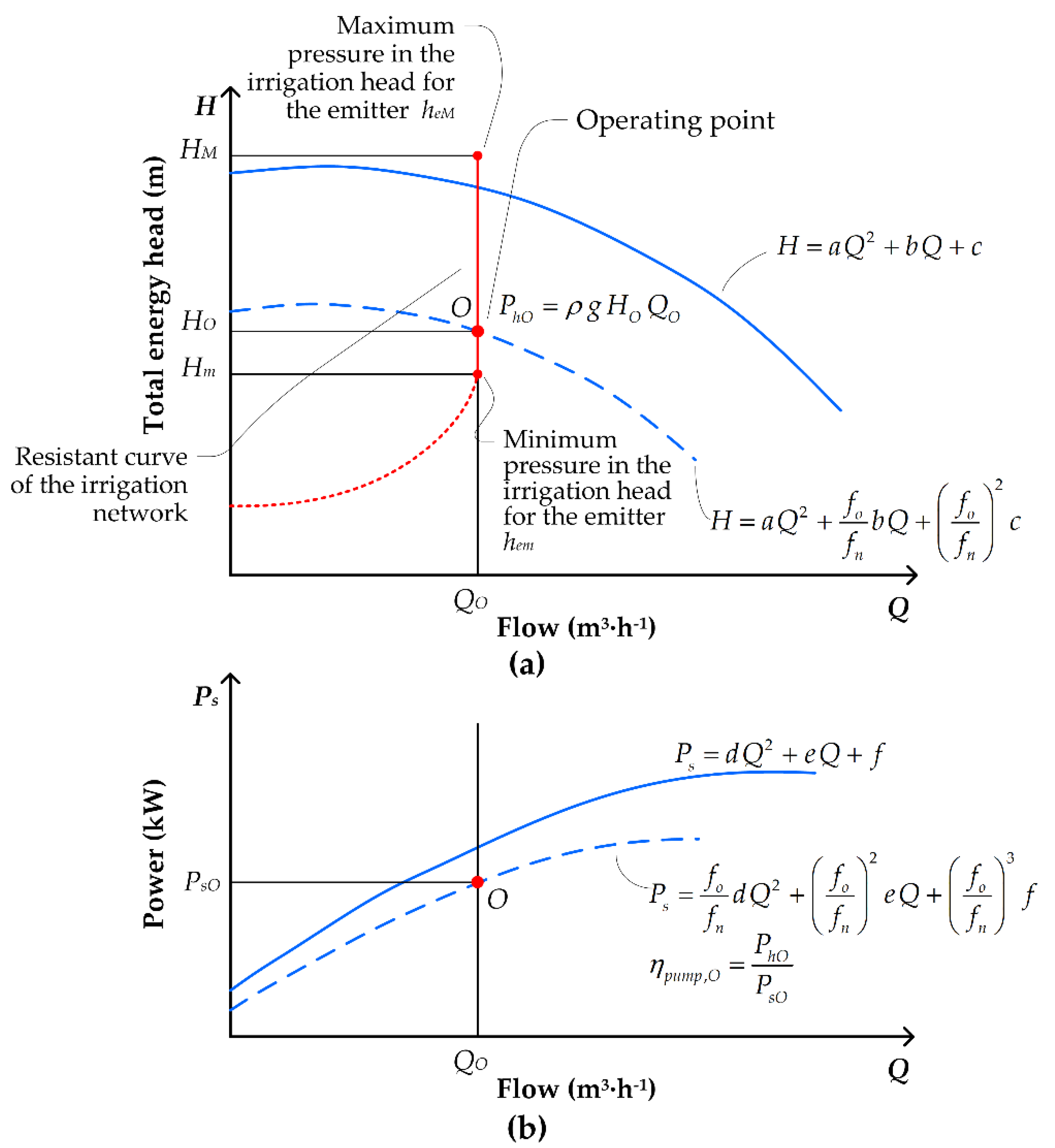
Appendix B. Abbreviations, Terms and Its Description
| C | Number of possible combinations of sectors under irrigation |
| D | Soil water deficit over a period of time (mm) |
| DWM | Daily work matrix |
| ETc | Crop evapotranspiration over a period of time (mm) |
| ETo | Reference crop evapotranspiration (mm) |
| EuE | Efficiency of the use of Energy |
| FC | Soil field capacity (mm) |
| fn | Electric motor rated frequency (50 Hz) |
| fo | Electric motor operating frequency, inverter frequency (Hz) |
| Fp | Generator loss factor (p.u.) |
| g | Gravity acceleration (m·s−2) |
| GHG | Greenhouse gas |
| H | Water flow energy, manometric head, supplied pressure (m.c.a.) |
| he | Emitter working pressure (m.c.a.) |
| heM | Compensated emitter maximum working pressure (bar) |
| hem | Compensated emitter minimum working pressure (bar) |
| hf | Pressure loss due to friction in the water pipe (m) |
| HM | Maximum pressure in the irrigation head so that heM is not exceeded (m.c.a.) |
| Hm | Minimum pressure in the irrigation head so that the most unfavourable emitter has hem (m.c.a.) |
| HO | Pressure required at the point of operation (m.c.a.) |
| Hsi | Necessary pressure at the origin of sector i to compensate for the pressure drop, the height difference and to maintain emitter working pressure (m.c.a.) |
| HSs | Pressure required in the irrigation head by the combination of sectors Ss (m.c.a.) |
| I(t) | Global irradiance as a function of time t (W·m−2) |
| Ib(t) | Direct solar irradiance as a function of time t (W·m−2) |
| Id(t) | Diffuse solar irradiance as a function of time t (W·m−2) |
| INF | Deep infiltration into the soil |
| Ir(t) | Albedo solar irradiance as a function of time t (W·m−2) |
| ISCT | Irradiance under standard conditions (1000 W·m−2) |
| j | Julian day |
| Kc | Crop coefficient, variable with the vegetative period |
| ke | Characteristic factor of the emitter |
| MAD | Management allowable depletion |
| n | Rotational speed of the rotor of the electric motor or pump (rpm) |
| ne,si | Total number of emitters of the irrigation sector i |
| NOCT | Cell nominal operating temperature (°C) |
| Pef | Effective precipitation over a period of time (mm) |
| Pelec | Electric power input to motor (W) |
| PG | Effective generator power (W) |
| PGSs | Effective generator power required by the combination of sectors Ss (W) |
| Ph | Hydraulic power (W) |
| PhO | Hydraulic power at operating point (W) |
| Pmpp | Peak power of the photovoltaic generator under standard conditions (W) |
| PPV | Photovoltaic generator power (W) |
| Ps | Mechanical power on the motor/pump shaft (W) |
| Ps,corr | Mechanical power on the motor shaft corrected to the operating frequency, fo (W) |
| PsO | Pump shaft power at operating point (W) |
| PWP | Permanent wilting point (mm) |
| Q | Water flow rate (m3·h−1) |
| qe | Emitter flow (L·h−1) |
| QO | Water flow rate at operating point (m3·h−1) |
| Qsi | Flow required by the irrigation sector i (m3·h−1) |
| QSs | Flow required by the combination of sectors Ss (m3·h−1) |
| RAW | Permissible depletion level (p.u.) |
| Rf | Coefficient of friction of the pipe and its accessories |
| Rfp | Coefficient of friction of the pipe and its accessories of the suction and discharge pipe of the main section |
| Rfsi | Coefficient of friction of the pipeline and its pipe accessories and correction coefficients of the sector network i |
| Rn | Effective irrigation carried out in a period of time (mm) |
| s | Number of sectors in which the farm has been divided |
| STC | Standard measurement conditions |
| t | Time |
| Ta | Ambient temperature (°C) |
| TAW | Range of available moisture in the soil (mm) |
| Tcell | Photovoltaic module cell temperature (°C) |
| TSTC | Cell temperature under standard conditions (25 °C) |
| β | Exponent of the flow, Q, in the head loss of a pipe |
| Δz | Elevation difference between water storage and the point of use (m) |
| Δzp | Elevation difference between the water storage and the irrigation distributor (m) |
| Δzsi | Elevation difference in the pipe network of each sector, i (m) |
| ε | Soil reflectivity (albedo) |
| γ | Coefficient of variation of cell performance due to cell temperature |
| ηmotor | Motor performance (p.u.) |
| ηpump | Pump performance (p.u.) |
| ηpump,O | Pump performance at operating point (p.u.) |
| ηVFD | Frequency inverter efficiency (p.u.) |
| φ | Angle of inclination of the photovoltaic modules |
| θ | Angle of incidence of direct solar radiation on the inclined plane of the solar panel |
| θz | Angle of incidence of direct solar radiation on the horizontal plane |
| ρ | Water density (kg·m−3) |
References
- Corominas, J. Agua y energía en el riego, en la época de la sostenibilidad. Ing. Del Agua 2010, 17, 219–233. [Google Scholar] [CrossRef] [Green Version]
- Senthil Kumar, S.; Bibin, C.; Akash, K.; Aravindan, K.; Kishore, M.; Magesh, G. Solar powered water pumping systems for irrigation: A comprehensive review on developments and prospects towards a green energy approach. Mater. Today Proc. 2020, 33, 303–307. [Google Scholar] [CrossRef]
- Hussin, F.; Issabayeva, G.; Aroua, M.K. Solar photovoltaic applications: Opportunities and challenges. Rev. Chem. Eng. 2018, 34, 503–528. [Google Scholar] [CrossRef]
- Campana, P.E.; Li, H.; Zhang, J.; Zhang, R.; Liu, J.; Yan, J. Economic optimization of photovoltaic water pumping systems for irrigation. Energy Convers. Manag. 2015, 95, 32–41. [Google Scholar] [CrossRef] [Green Version]
- Instituto de Energía Solar (UPM) Gráficos Significativos Energía Solar Fotovoltaica. 2018, p. 61. Available online: https://www.ies.upm.es/sfs/IES/IES-UPM/Portada/2018_PV_Espa%c3%b1a.pdf (accessed on 9 August 2021).
- Bouzidi, B. New sizing method of PV water pumping systems. Sustain. Energy Technol. Assess. 2013, 4, 1–10. [Google Scholar] [CrossRef]
- Posadillo, R.; López Luque, R. A sizing method for stand-alone PV installations with variable demand. Renew. Energy 2008, 33, 1049–1055. [Google Scholar] [CrossRef]
- Reca-Cardeña, J.; López-Luque, R. Design Principles of Photovoltaic Irrigation Systems. Adv. Renew. Energies Power Technol. 2018, 1, 295–333. [Google Scholar]
- Sontake, V.C.; Kalamkar, V.R. Solar photovoltaic water pumping system—A comprehensive review. Renew. Sustain. Energy Rev. 2016, 59, 1038–1067. [Google Scholar] [CrossRef]
- Orts-Grau, S.; Gonzalez-Altozano, P.; Gimeno-Sales, F.J.; Balbastre-Peralta, I.; Marquez, C.I.M.; Gasque, M.; Segui-Chilet, S. Photovoltaic Water Pumping: Comparison between Direct and Lithium Battery Solutions. IEEE Access 2021, 9, 101147–101163. [Google Scholar] [CrossRef]
- López-Luque, R.; Reca, J.; Martínez, J. Optimal design of a standalone direct pumping photovoltaic system for deficit irrigation of olive orchards. Appl. Energy 2015, 149, 13–23. [Google Scholar] [CrossRef]
- Hamidat, A.; Benyoucef, B. Systematic procedures for sizing photovoltaic pumping system, using water tank storage. Energy Policy 2009, 37, 1489–1501. [Google Scholar] [CrossRef]
- Hamidat, A.; Benyoucef, B.; Hartani, T. Small-scale irrigation with photovoltaic water pumping system in Sahara regions. Renew. Energy 2003, 28, 1081–1096. [Google Scholar] [CrossRef]
- Meah, K.; Fletcher, S.; Ula, S. Solar photovoltaic water pumping for remote locations. Renew. Sustain. Energy Rev. 2008, 12, 472–487. [Google Scholar] [CrossRef]
- Yang, H.; Lu, L.; Zhou, W. A novel optimization sizing model for hybrid solar-wind power generation system. Sol. Energy 2007, 81, 76–84. [Google Scholar] [CrossRef]
- Zhou, W.; Lou, C.; Li, Z.; Lu, L.; Yang, H. Current status of research on optimum sizing of stand-alone hybrid solar-wind power generation systems. Appl. Energy 2010, 87, 380–389. [Google Scholar] [CrossRef]
- Kamel, S.; Dahl, C. The economics of hybrid power systems for sustainable desert agriculture in Egypt. Energy 2005, 30, 1271–1281. [Google Scholar] [CrossRef]
- Carroquino, J.; Dufo-López, R.; Bernal-Agustín, J.L. Sizing of off-grid renewable energy systems for drip irrigation in Mediterranean crops. Renew. Energy 2015, 76, 566–574. [Google Scholar] [CrossRef]
- Dufo-López, R.; Bernal-Agustín, J.L.; Yusta-Loyo, J.M.; Domínguez-Navarro, J.A.; Ramírez-Rosado, I.J.; Lujano, J.; Aso, I. Multi-objective optimization minimizing cost and life cycle emissions of stand-alone PV–wind–diesel systems with batteries storage. Appl. Energy 2011, 88, 4033–4041. [Google Scholar] [CrossRef]
- Muhsen, D.H.; Khatib, T.; Abdulabbas, T.E. Sizing of a standalone photovoltaic water pumping system using hybrid multi-criteria decision making methods. Sol. Energy 2018, 159, 1003–1015. [Google Scholar] [CrossRef]
- Ramli, M.A.M.; Bouchekara, H.R.E.H.; Alghamdi, A.S. Optimal sizing of PV/wind/diesel hybrid microgrid system using multi-objective self-adaptive differential evolution algorithm. Renew. Energy 2018, 121, 400–411. [Google Scholar] [CrossRef]
- Haffaf, A.; Lakdja, F.; Meziane, R.; Abdeslam, D.O. Study of economic and sustainable energy supply for water irrigation system (WIS). Sustain. Energy Grids Netw. 2021, 25, 100412. [Google Scholar] [CrossRef]
- Benlarbi, K.; Mokrani, L.; Nait-Said, M.S. A fuzzy global efficiency optimization of a photovoltaic water pumping system. Sol. Energy 2004, 77, 203–216. [Google Scholar] [CrossRef]
- Ghoneim, A.A. Design optimization of photovoltaic powered water pumping systems. Energy Convers. Manag. 2006, 47, 1449–1463. [Google Scholar] [CrossRef]
- Glasnovic, Z.; Margeta, J. A model for optimal sizing of photovoltaic irrigation water pumping systems. Sol. Energy 2007, 81, 904–916. [Google Scholar] [CrossRef]
- Campana, P.E.; Li, H.; Yan, J. Dynamic modelling of a PV pumping system with special consideration on water demand. Appl. Energy 2013, 112, 635–645. [Google Scholar] [CrossRef] [Green Version]
- Gao, X.; Liu, J.; Zhang, J.; Yan, J.; Bao, S.; Xu, H.; Qin, T. Feasibility evaluation of solar photovoltaic pumping irrigation system based on analysis of dynamic variation of groundwater table. Appl. Energy 2013, 105, 182–193. [Google Scholar] [CrossRef]
- Reca, J.; Torrente, C.; López-Luque, R.; Martínez, J. Feasibility analysis of a standalone direct pumping photovoltaic system for irrigation in Mediterranean greenhouses. Renew. Energy 2016, 85, 1143–1154. [Google Scholar] [CrossRef] [Green Version]
- Gualteros, S.; Rousse, D.R. Solar water pumping systems: A tool to assist in sizing and optimization. Sol. Energy 2021, 225, 382–398. [Google Scholar] [CrossRef]
- Allouhi, A.; Buker, M.S.; El-houari, H.; Boharb, A.; Benzakour Amine, M.; Kousksou, T.; Jamil, A. PV water pumping systems for domestic uses in remote areas: Sizing process, simulation and economic evaluation. Renew. Energy 2019, 132, 798–812. [Google Scholar] [CrossRef]
- Mana, A.; Allouhi, A.; Ouazzani, K.; Jamil, A. Toward a Sustainable Agriculture in Morocco Based on Standalone PV Pumping Systems: A Comprehensive Approach. Green Energy Technol. 2021, 399–433. [Google Scholar] [CrossRef]
- Ehrmann, S.; Fickert, L.; Nolz, R. Optimizing the setup of a photovoltaic pumping system for irrigation considering different crop water requirements. JPE 2019, 9, 043104. [Google Scholar] [CrossRef]
- Cuadros, F.; López-Rodríguez, F.; Marcos, A.; Coello, J. A procedure to size solar-powered irrigation (photoirrigation) schemes. Sol. Energy 2004, 76, 465–473. [Google Scholar] [CrossRef]
- Campana, P.E.; Zhu, Y.; Brugiati, E.; Li, H.; Yan, J. PV water pumping for irrigation equipped with a novel control system for water savings. Energy Procedia 2014, 61, 949–952. [Google Scholar] [CrossRef] [Green Version]
- Mérida García, A.; Fernández García, I.; Camacho Poyato, E.; Montesinos Barrios, P.; Rodríguez Díaz, J.A. Coupling irrigation scheduling with solar energy production in a smart irrigation management system. J. Clean. Prod. 2018, 175, 670–682. [Google Scholar] [CrossRef]
- Zavala, V.; López-Luque, R.; Reca, J.; Martínez, J.; Lao, M.T. Optimal management of a multisector standalone direct pumping photovoltaic irrigation system. Appl. Energy 2020, 260, 114261. [Google Scholar] [CrossRef]
- Doorenbos, J.; Pruitt, W.O. Crop Water Requirements. FAO Irrig. Drain. 1977, 24, 144. [Google Scholar]
- Allen, R.G.; Food and Agriculture Organization of the United Nations. Crop Evapotranspiration: Guidelines for Computing Crop Water Requirements; Food and Agriculture Organization of the United Nations: Rome, Italy, 1998; ISBN 9251042195. [Google Scholar]
- Villalobos, F.J.; Mateos, L.; Ogaz, F.; Fereres, E. Fitotecnia: Bases y Tecnologías de la Producción Agrícola; Mundi-Prensa: Madrid, Spain, 2009; ISBN 9788484765288. [Google Scholar]
- Dastane, N.G.; Food and Agriculture Organization of the United Nations. Effective Rainfall in Irrigated Agriculture; Food and Agriculture Organization of the United Nations: Rome, Italy, 1974; ISBN 925100272X. [Google Scholar]
- Línea ULTRA-Módulos Fotovoltaicos-Productos y Servicios-Atersa. Available online: https://atersa.com/es/productos-servicios/modulos-fotovoltaicos/linea-ultra/ (accessed on 21 August 2021).
- Orgaz, F.; Fereres, E.; Testi, L. Riego. In El Cultivo del Olivo; Barranco, D., Fernández-Escobar, R., Rallo, L., Eds.; Ediciones Mundi-Prensa: Madrid, Spain, 2017; pp. 461–490. ISBN 978-84-8476-714-5. [Google Scholar]
- Pastor Muñoz-Cobo, M. Olivicultura y elaiotecnia. In Programació de Riegos en Olivar; Junta de Andalucía, Consejería de Agricultura y Pesca: Sevilla, Spain, 2001; ISBN 8484740323. [Google Scholar]
- NB|Grundfos. Available online: https://product-selection.grundfos.com/es/products/nb-nbe-nbe-series-2000/nb?tab=models (accessed on 21 August 2021).
- ABB Low Voltage. General Performance Motors. Catalog; ABB: Zurich, Switzerland, 2018. [Google Scholar]
- SD700|Power Electronics. Available online: https://power-electronics.com/es/productos/productos-industrial/sd700/ (accessed on 21 August 2021).
- Agencia Andaluza de la Energía. Consejería de Innovación, C. y E. Mapa de Radiación Solar. Available online: https://www.agenciaandaluzadelaenergia.es/Radiacion/radiacion1.php (accessed on 19 July 2020).
- MATLAB-El Lenguaje del Cálculo Técnico-MATLAB & Simulink. Available online: https://es.mathworks.com/products/matlab.html (accessed on 20 October 2021).
- Duffie, J.A.; Beckman, W.A. Solar Radiation, 4th ed.; Wiley Online Books: New York, NY, USA, 2013; ISBN 9781118671603. [Google Scholar]
- Collares-Pereira, M.; Rabl, A. The average distribution of solar radiation-correlations between diffuse and hemispherical and between daily and hourly insolation values. Sol. Energy 1979, 22, 155–164. [Google Scholar] [CrossRef]
- Fraile Mora, J.; Fraile Ardanuy, J. Accionamientos Eléctricos, 1st ed.; Ibergarceta: Madrid, Spain, 2016; ISBN 9788416228492. [Google Scholar]
- AENOR. Ecodesign for Power Drive Systems, Motor Starters, Power Electronics & Their Driven Applications—Part 2: Energy Efficiency Indicators for Power Drive Systems and Motor Starters, UNE-EN 50598-2; AENOR: Madrid, Spain, 2015. [Google Scholar]
- Abella, M.A.; Lorenzo, E.; Chenlo, F. PV water pumping systems based on standard frequency converters. Prog. Photovolt. Res. Appl. 2003, 11, 179–191. [Google Scholar] [CrossRef]
- Alonso-Abella, M.; Lorenzo, E.; Chenlo, F. Sistemas de bombeo fotovoltaico. Optimización del uso de convertidores de frecuencia con bombas centrífugas y motores trifásicos. In Era Solar: Energías Renovables, No 106; SAPT Publicaciones Técnicas S.L.: Madrid, Spain, 2002; pp. 14–35. [Google Scholar]
- Bhave, P.R. Analysis of Flow in Water Distribution Networks; Technomic Publishing: Lancaster, UK, 1991. [Google Scholar]
- Ángeles Montiel, V.; Arteaga Ramírez, R.; Vázquez Peña, M.A.; Carrillo García, M.; Ibáñez Castillo, L.A. Factores de ajuste para la pérdida de carga por fricción en tuberías con salidas múltiples telescópicas o con servicio mixto. Ing. Del Agua 2007, 14, 293–305. [Google Scholar] [CrossRef] [Green Version]
- Pereira, L.; de Juan Valero, J.; Raquel Picornell Buendia, M.; Tarjuelo Martin-Benito, J. El Riego y sus Tecnologías; CREA-UCLM: Albacete, Spain, 2010; ISBN 13-978-84-692-9979-1. [Google Scholar]
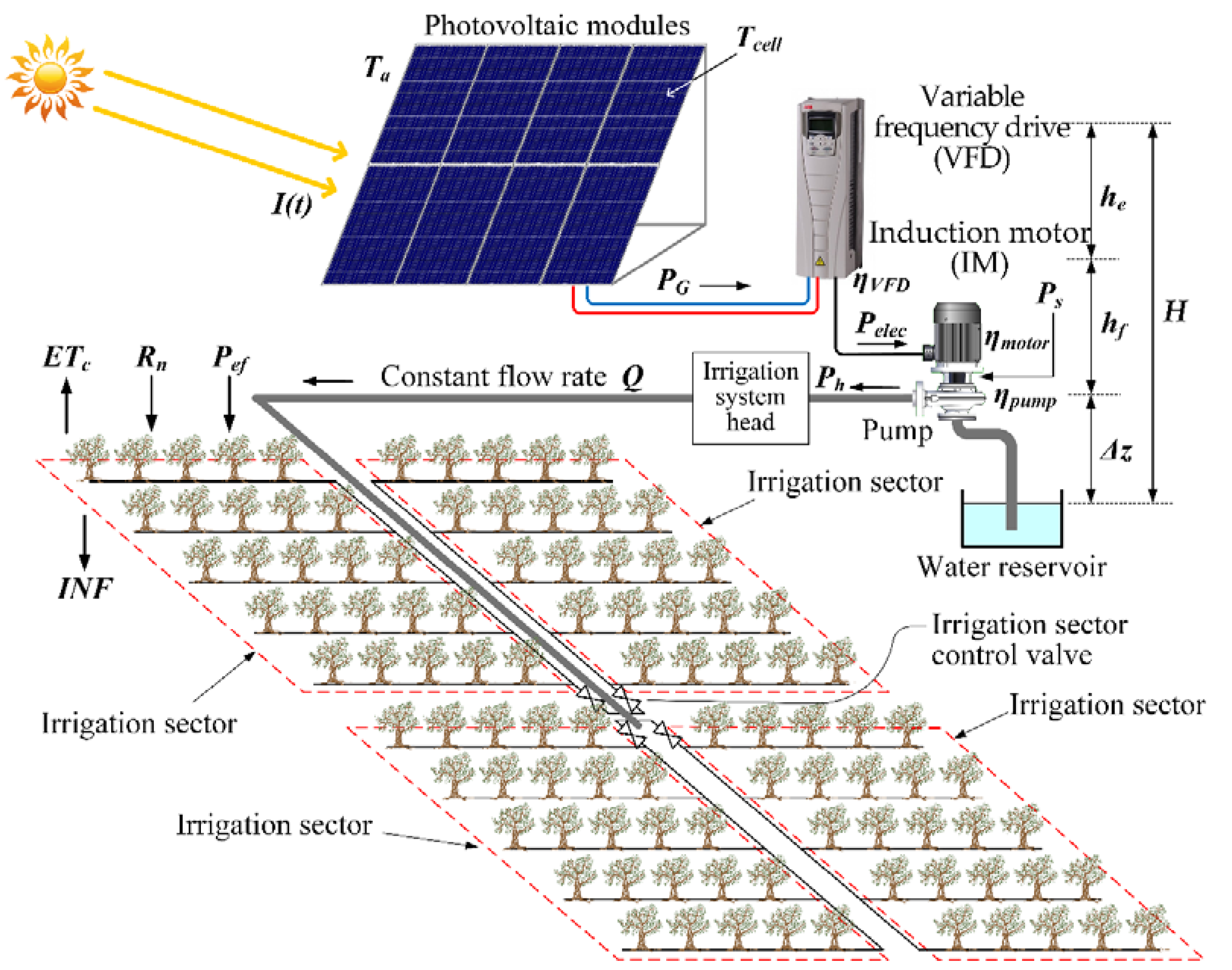

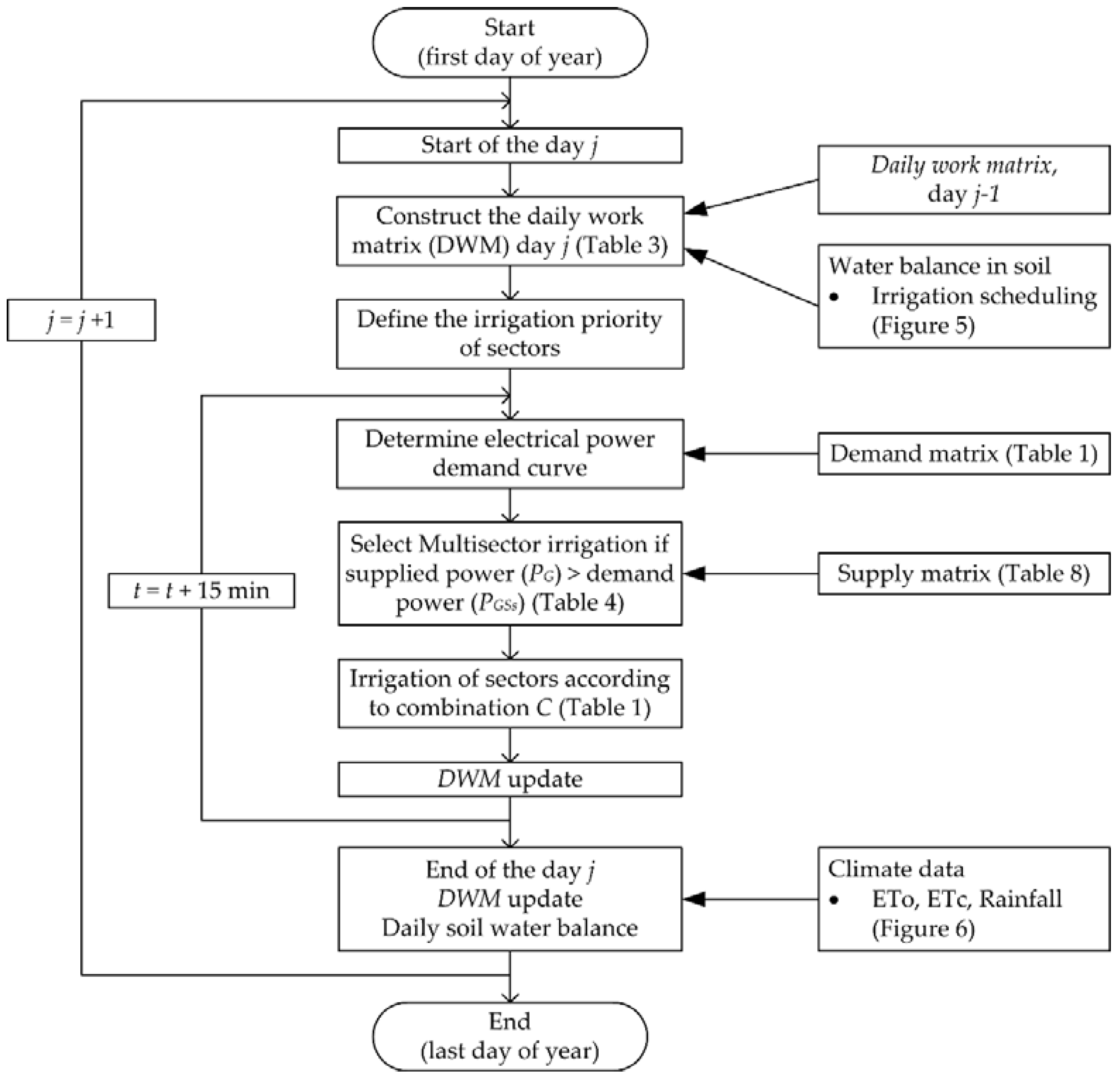
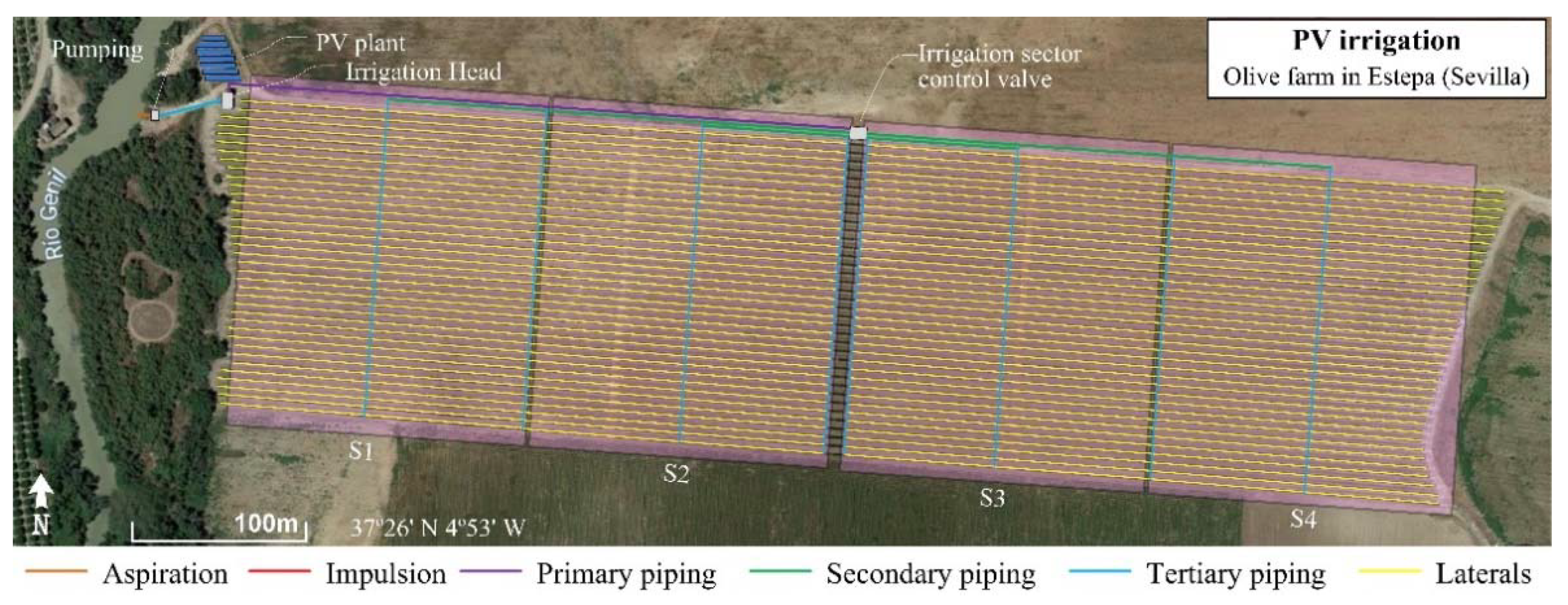
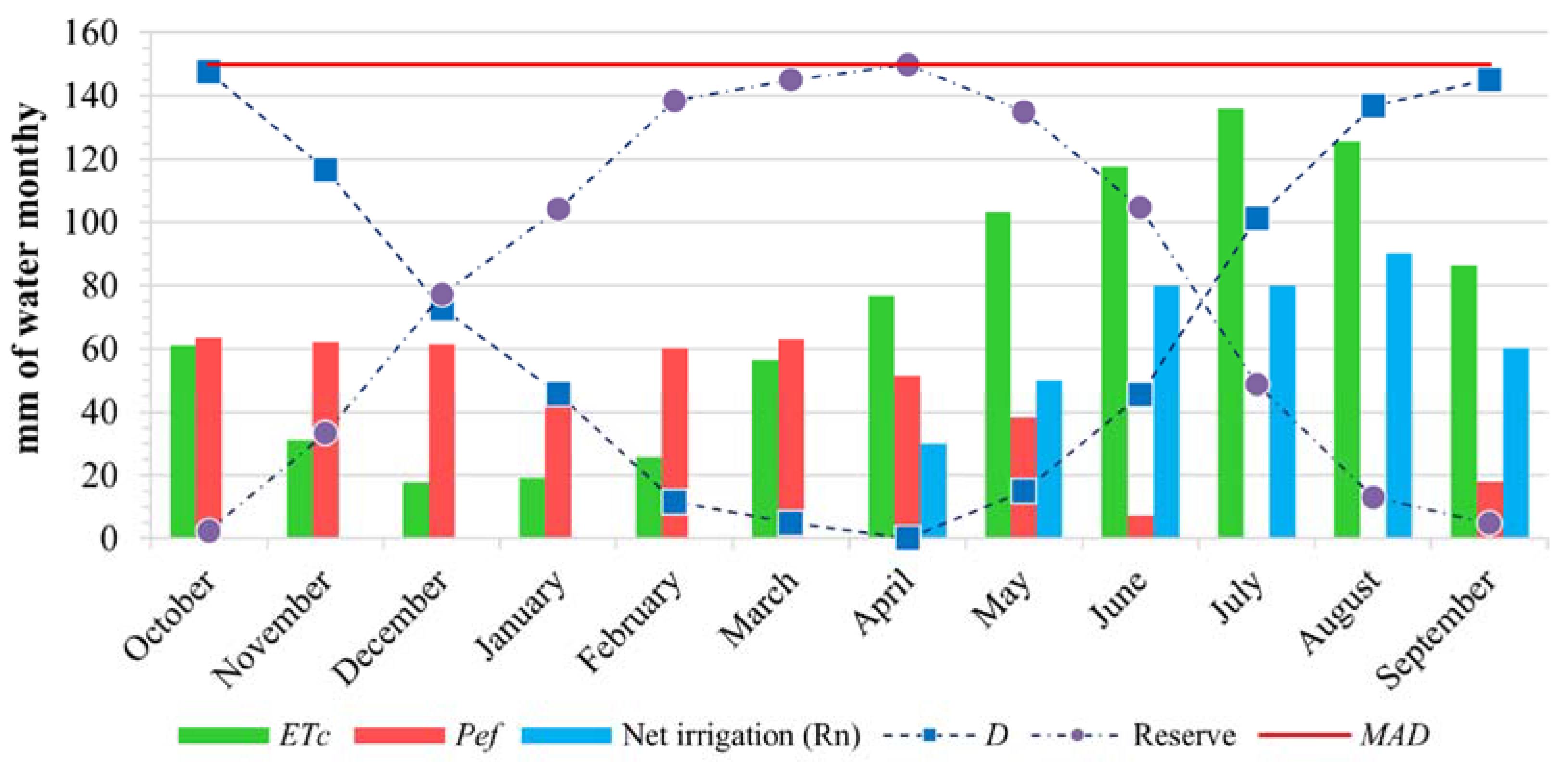
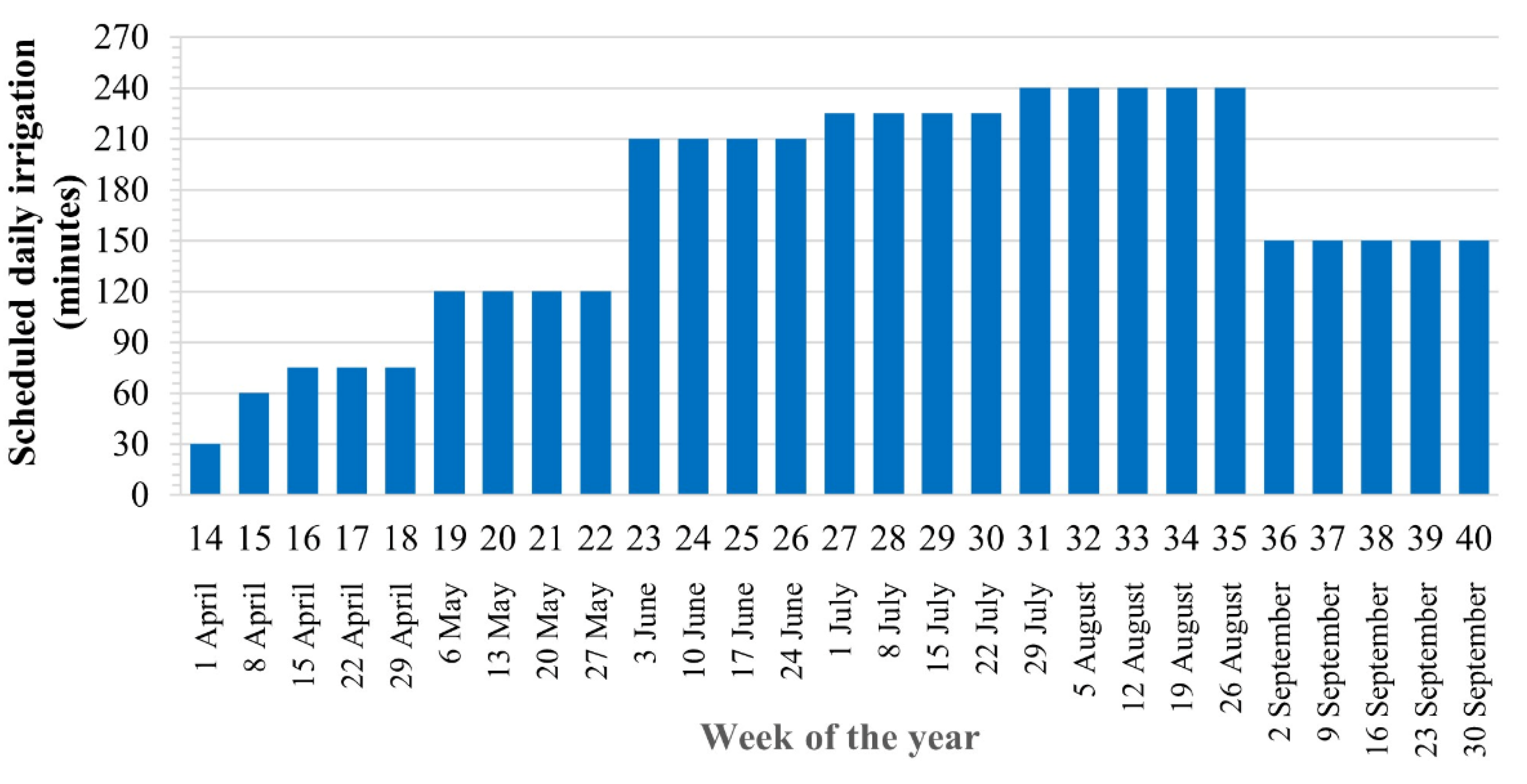

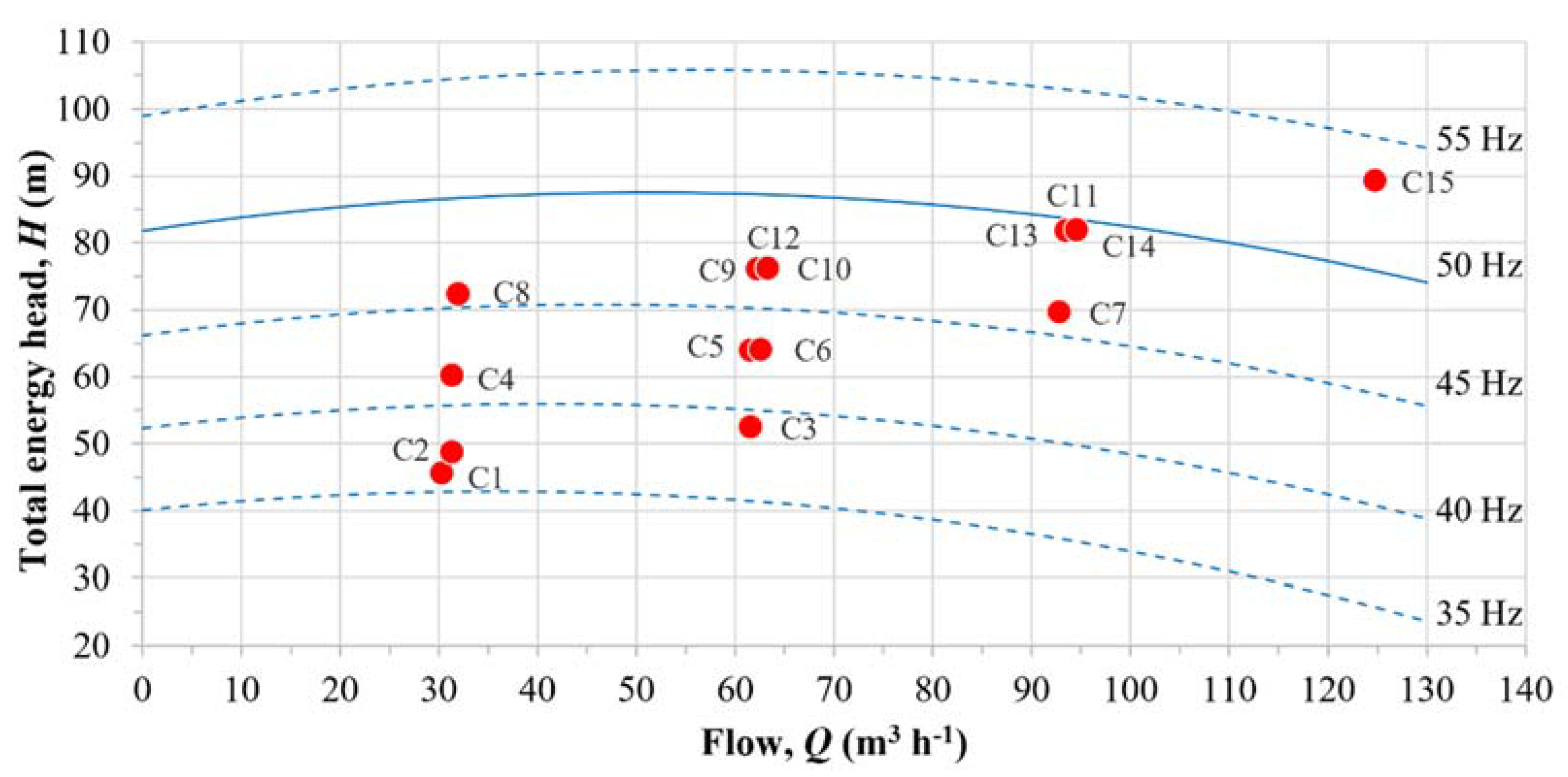

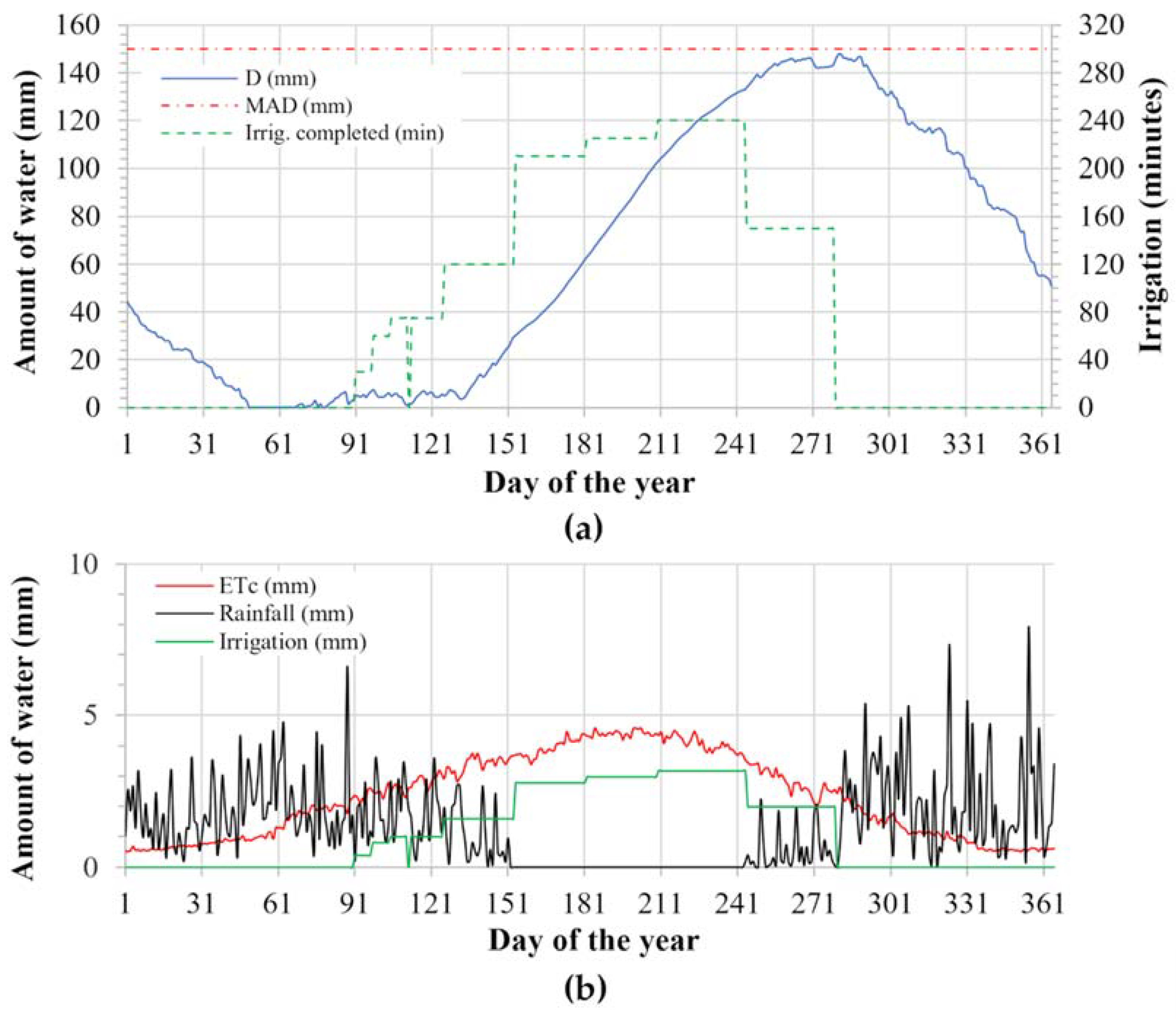
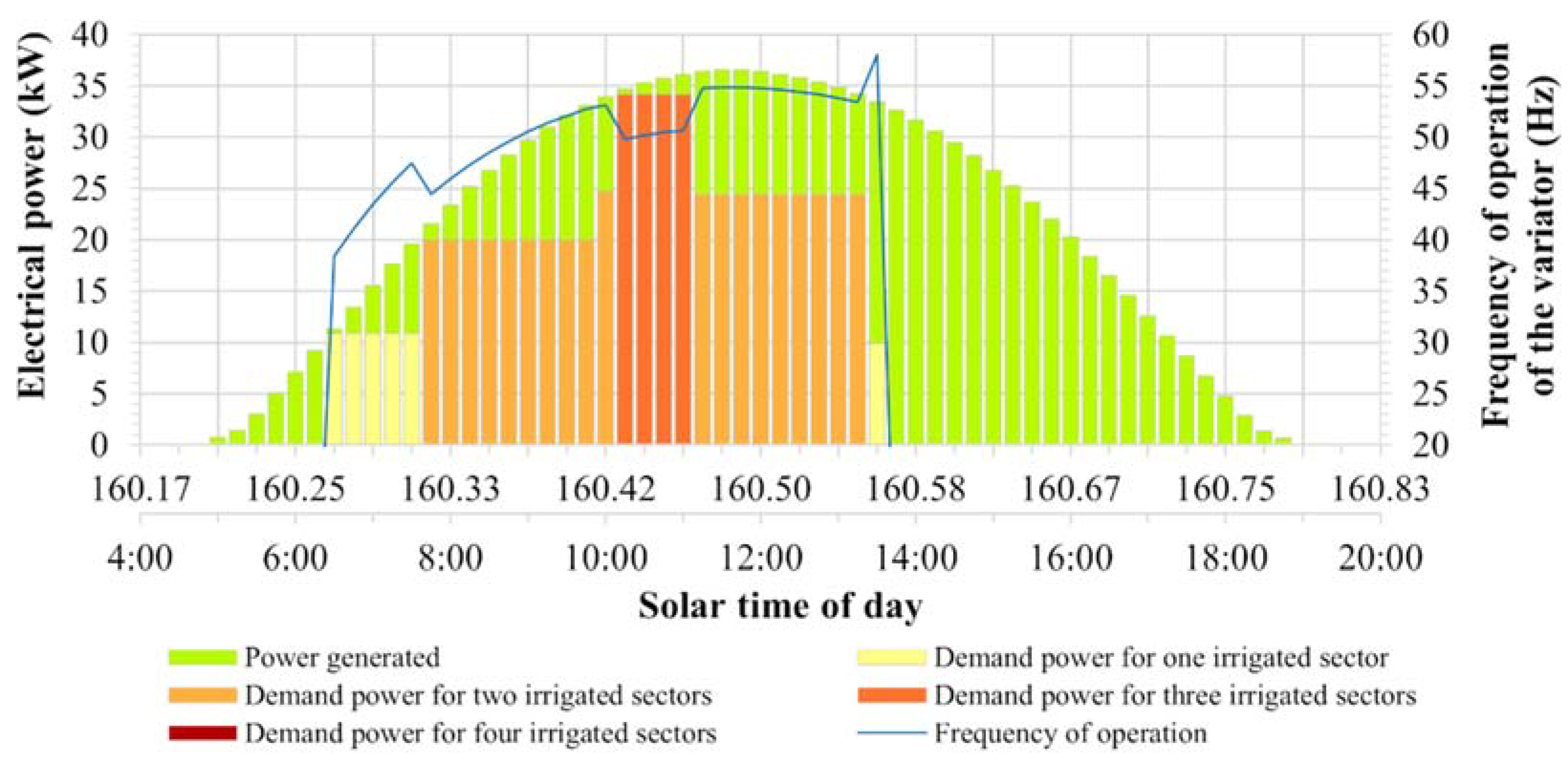


| 1 | 2 | 3 | 4 | ||||||
|---|---|---|---|---|---|---|---|---|---|
| Decimal | Binary | Flow Q | Height H | Power PG | |||||
| Ss | ⋯ | S4 | S3 | S2 | S1 | ||||
| 01 | 0 | ⋯ | 0 | 0 | 0 | 1 | Q1s | H1s | PG1s |
| 02 | 0 | ⋯ | 0 | 0 | 1 | 0 | Q1s | H1s | PG1s |
| 03 | 0 | ⋯ | 0 | 0 | 1 | 1 | Q2s | H2s | PG2s |
| 04 | 0 | ⋯ | 0 | 1 | 0 | 0 | Q1s | H1s | PG1s |
| 05 | 0 | ⋯ | 0 | 1 | 0 | 1 | Q2s | H2s | PG2s |
| 06 | 0 | ⋯ | 0 | 1 | 1 | 0 | Q2s | H2s | PG2s |
| 07 | 0 | ⋯ | 0 | 1 | 1 | 1 | Q3s | H3s | PG3s |
| 08 | 0 | ⋯ | 1 | 0 | 0 | 0 | Q1s | H1s | PG1s |
| 09 | 0 | ⋯ | 1 | 0 | 0 | 1 | Q2s | H2s | PG2s |
| 10 | 0 | ⋯ | 1 | 0 | 1 | 0 | Q2s | H2s | PG2s |
| 11 | 0 | ⋯ | 1 | 0 | 1 | 1 | Q3s | H3s | PG3s |
| 12 | 0 | ⋯ | 1 | 1 | 0 | 0 | Q2s | H2s | PG2s |
| 13 | 0 | ⋯ | 1 | 1 | 0 | 1 | Q3s | H3s | PG3s |
| 14 | 0 | ⋯ | 1 | 1 | 1 | 0 | Q3s | H3s | PG3s |
| 15 | 0 | ⋯ | 1 | 1 | 1 | 1 | Q4s | H4s | PG4s |
| ⋮ | ⋮ | ⋮ | ⋮ | ⋮ | ⋮ | ⋮ | ⋮ | ⋮ | ⋮ |
| C | 1 | ⋯ | 1 | 1 | 1 | 1 | QSs | HSs | PGSs |
| Row. | |
|---|---|
| 1 | Number of the sector |
| 2 | Irrigation demand for day ‘j’ |
| 3 | Irrigation deficit from the previous day |
| 4 | Total deficit, updated throughout the day |
| 5 | D, at the start of day ‘j’ |
| 6 | Irrigation applied during day ‘j’ |
| 7 | D updated |
| 8 | Priority of sectors for irrigation |
| 9 | Combination of sectors for multisectoral irrigation, according to the priority fixed for row 8. |
| 10 | Power of demand for the priority of fixed sector |
| 11 | Sectors in irrigation (0 = without irrigation, 1 = irrigating) |
| Row 1 | s | Number of sector, s |
| Row 2 | Rprg,j,s | Irrigation programmed for day j and sector s (in min) |
| Row 3 | Rprg,j−1,s − ΣRj−1,s | Irrigation pending the previous day j−1 |
| Row 4 | Rprg,j,s +(Rprg,j−1,s − ΣRj−1,s) − ΣRj,s | Updated value of irrigation pending on day j, as f(t) |
| Row 5 | Dj−1,s | D value that ended on day j−1 (in mm) |
| Row 6 | ΣRnj,s | Updated value of irrigation of day j (in mm) |
| Row 7 | Dj,s = Dj−1,s − ΣRnj,s | Updated value of D for day j |
| Row 8 | Dj−1 = {Dj−1,1, Dj−1,2, …} Rtotal,j = {Rtotal,j,1, Rtotal,j,2, …} (Dj−1, ≥) ∪ (Rtotal,j, ≥) | Set of sectors ordered from highest to lowest D and irrigation time |
| ↓ | ||
| Row 9 | {C(s,i)} | Set of combinations of sectors ordered according to row 8 |
| ↓ | ||
| Row 10 | {PGSs Ɐ C(s,i)} | Set of the powers PGSs required for each combination of row 9 |
| Row 11 | {0, 1} | Irrigation status values for sector s (0 = not irrigating, 1 = irrigating) |
| Condition | Sectors in Irrigation | |
|---|---|---|
| If | No sector | |
| If | One sector, the of major priority | |
| If | Two sectors, both of major priority | |
| If | Three sectors, all 3 of major priority | |
| If | Four sectors, all 4 of major priority | |
| If | ⋮ | ⋮ |
| If | ‘s’ sectors (all the sectors) |
| Variable | Value |
|---|---|
| Distance between trees | 1.5 m |
| Distance between rows | 5 m |
| Tree density | 1333 trees·ha−1 |
| Volume of treetop | 3.75 m3 |
| Volume of treetop by area | 0.5 m3/m2 |
| Variable | Value |
|---|---|
| Depth of rooting plants | 1 m |
| Soil field capacity, FC | 0.37 m3/m3 |
| Permanent wilting point, PWP | 0.17 m3/m3 |
| Permissible depletion level, RAW | 0.75 p.u. |
| Available humidity range TAW | 0.2 m3/m3 |
| Management allowable depletion, MAD | 150 mm |
| Variable | Value |
|---|---|
| Peak power | 315 Wp |
| Maximum power point current Impp | 8.45 A |
| Maximum power point voltage Vmpp | 37.3 V |
| Temperature coefficient of P (γ) | −0.43%/°C |
| Nominal operating temperature NOCT | 47 °C |
| Date and Hour | Ta (°C) | Ib(t) (W·m−2) | Id(t) (W·m−2) | Ir(t) (W·m−2) | I(t) (W·m−2) | PPV (W) | PG (kW) |
|---|---|---|---|---|---|---|---|
| ⁞ | ⁞ | ⁞ | ⁞ | ⁞ | ⁞ | ⁞ | ⁞ |
| 18-Aug 8:45 A.M. | 24.44 | 466.290 | 200.633 | 1.977 | 668.899 | 30,865.38 | 26.54 |
| 18-Aug 9:00 A.M. | 25.14 | 506.923 | 212.025 | 2.125 | 721.073 | 32,657.90 | 28.09 |
| 18-Aug 9:15 A.M. | 25.85 | 546.188 | 222.695 | 2.268 | 771.151 | 34,288.46 | 29.49 |
| 18-Aug 9:30 A.M. | 26.56 | 583.673 | 232.597 | 2.403 | 818.673 | 35,752.07 | 30.75 |
| 18-Aug 9:45 A.M. | 27.29 | 618.977 | 241.688 | 2.530 | 863.195 | 37,046.49 | 31.86 |
| 18-Aug 10:00 A.M. | 28.01 | 651.716 | 249.931 | 2.648 | 904.294 | 38,172.01 | 32.83 |
| 18-Aug 10:15 A.M. | 28.72 | 681.531 | 257.289 | 2.754 | 941.573 | 39,131.00 | 33.65 |
| ⁞ | ⁞ | ⁞ | ⁞ | ⁞ | ⁞ | ⁞ | ⁞ |
| 1 | 2 | 3 | 4 | 5 | 6 | 7 | 8 | 9 | 10 | |||||
|---|---|---|---|---|---|---|---|---|---|---|---|---|---|---|
| Combination of Sectors in Irrigation (Decimal) | Sectors in Irrigation (Binary) | Q (m3·h−1) | H (m.c.a.) | Ph (kW) | ηpump (p.u.) | Ps (kW) | fo (Hz) | ηmotor (p.u.) | Pelec (kW) | ηVFD (p.u.) | PG (kW) | |||
| S4 | S3 | S2 | S1 | |||||||||||
| 1 | 0 | 0 | 0 | 1 | 30.281 | 45.626 | 3.762 | 0.433 | 8.680 | 36.152 | 0.897 | 9.677 | 0.976 | 9.915 |
| 2 | 0 | 0 | 1 | 0 | 31.258 | 48.796 | 4.154 | 0.433 | 9.595 | 37.388 | 0.905 | 10.607 | 0.976 | 10.866 |
| 4 | 0 | 1 | 0 | 0 | 31.258 | 60.280 | 5.131 | 0.402 | 12.752 | 41.606 | 0.923 | 13.822 | 0.976 | 14.155 |
| 8 | 1 | 0 | 0 | 0 | 31.990 | 72.328 | 6.301 | 0.383 | 16.441 | 45.618 | 0.935 | 17.591 | 0.977 | 18.002 |
| 3 | 0 | 0 | 1 | 1 | 61.538 | 52.484 | 8.795 | 0.615 | 14.296 | 39.095 | 0.928 | 15.398 | 0.976 | 15.772 |
| 5 | 0 | 1 | 0 | 1 | 61.538 | 63.967 | 10.720 | 0.590 | 18.154 | 42.977 | 0.938 | 19.346 | 0.977 | 19.809 |
| 9 | 1 | 0 | 0 | 1 | 62.271 | 76.062 | 12.899 | 0.570 | 22.618 | 46.760 | 0.945 | 23.931 | 0.978 | 24.481 |
| 6 | 0 | 1 | 1 | 0 | 62.515 | 64.117 | 10.916 | 0.594 | 18.367 | 43.050 | 0.939 | 19.564 | 0.977 | 20.032 |
| 10 | 1 | 0 | 1 | 0 | 63.248 | 76.213 | 13.127 | 0.574 | 22.857 | 46.824 | 0.945 | 24.177 | 0.978 | 24.733 |
| 12 | 1 | 1 | 0 | 0 | 63.248 | 76.213 | 13.127 | 0.574 | 22.857 | 46.824 | 0.945 | 24.177 | 0.978 | 24.733 |
| 7 | 0 | 1 | 1 | 1 | 92.796 | 69.647 | 17.600 | 0.664 | 26.488 | 46.034 | 0.949 | 27.923 | 0.977 | 28.572 |
| 11 | 1 | 0 | 1 | 1 | 93.529 | 81.784 | 20.831 | 0.654 | 31.828 | 49.503 | 0.951 | 33.454 | 0.979 | 34.184 |
| 13 | 1 | 1 | 0 | 1 | 93.529 | 81.784 | 20.831 | 0.654 | 31.828 | 49.503 | 0.951 | 33.454 | 0.979 | 34.184 |
| 14 | 1 | 1 | 1 | 0 | 94.505 | 81.992 | 21.102 | 0.656 | 32.173 | 49.610 | 0.952 | 33.812 | 0.979 | 34.548 |
| 15 | 1 | 1 | 1 | 1 | 124.786 | 89.257 | 30.332 | 0.676 | 44.897 | 53.426 | 0.953 | 47.111 | 0.981 | 48.037 |
| At Start of Day | At 9:00 h Solar | At End of Day | |||||||||||||
|---|---|---|---|---|---|---|---|---|---|---|---|---|---|---|---|
| Day 160 | 1 | 2 | 3 | 4 | 1 | 2 | 3 | 4 | 1 | 2 | 3 | 4 | |||
| 1 | 1 | 2 | 3 | 4 | 1 | 1 | 2 | 3 | 4 | 1 | 1 | 2 | 3 | 4 | |
| 2 | 210 | 210 | 210 | 210 | 2 | 210 | 210 | 210 | 210 | 2 | 210 | 210 | 210 | 210 | |
| 3 | 0 | 0 | 0 | 0 | 3 | 0 | 0 | 0 | 0 | 3 | 0 | 0 | 0 | 0 | |
| 4 | 210 | 210 | 210 | 210 | 4 | 210 | 45 | 120 | 210 | 4 | 0 | 0 | 0 | 0 | |
| 5 | 34.80 | 34.80 | 34.80 | 34.80 | 5 | 34.80 | 34.80 | 34.80 | 34.80 | 5 | 34.80 | 34.80 | 34.80 | 34.80 | |
| 6 | 0.00 | 0.00 | 0.00 | 0.00 | 6 | 0.00 | 2.18 | 1.19 | 0.00 | 6 | 2.77 | 2.77 | 2.77 | 2.77 | |
| 7 | 34.80 | 34.80 | 34.80 | 34.80 | 7 | 34.80 | 32.62 | 33.61 | 34.80 | 7 | 35.42 | 35.42 | 35.42 | 35.42 | |
| 8 | 4 | 1 | 2 | 3 | 8 | 4 | 1 | 2 | 3 | 8 | 0 | 0 | 0 | 0 | |
| 9 | 15 | 2 | 6 | 14 | 9 | 15 | 2 | 6 | 14 | 9 | 0 | 0 | 0 | 0 | |
| 10 | 48.04 | 10.87 | 20.03 | 34.55 | 10 | 48.04 | 10.87 | 20.03 | 34.55 | 10 | 0.00 | 0.00 | 0.00 | 0.00 | |
| 11 | 0 | 0 | 0 | 0 | 11 | 0 | 1 | 1 | 0 | 11 | 0 | 0 | 0 | 0 | |
Publisher’s Note: MDPI stays neutral with regard to jurisdictional claims in published maps and institutional affiliations. |
© 2021 by the authors. Licensee MDPI, Basel, Switzerland. This article is an open access article distributed under the terms and conditions of the Creative Commons Attribution (CC BY) license (https://creativecommons.org/licenses/by/4.0/).
Share and Cite
Calero-Lara, M.; López-Luque, R.; Casares, F.J. Methodological Advances in the Design of Photovoltaic Irrigation. Agronomy 2021, 11, 2313. https://doi.org/10.3390/agronomy11112313
Calero-Lara M, López-Luque R, Casares FJ. Methodological Advances in the Design of Photovoltaic Irrigation. Agronomy. 2021; 11(11):2313. https://doi.org/10.3390/agronomy11112313
Chicago/Turabian StyleCalero-Lara, Martín, Rafael López-Luque, and Francisco José Casares. 2021. "Methodological Advances in the Design of Photovoltaic Irrigation" Agronomy 11, no. 11: 2313. https://doi.org/10.3390/agronomy11112313
APA StyleCalero-Lara, M., López-Luque, R., & Casares, F. J. (2021). Methodological Advances in the Design of Photovoltaic Irrigation. Agronomy, 11(11), 2313. https://doi.org/10.3390/agronomy11112313







